The dead tree that had fallen over the river was messing up my ability to fish the pool and generally pissing me off. It was pretty skeletal and rickety-looking, though, so it occurred to me that I might be able to break off at least the top portion—enough to create a casting lane. This stream improvement project would render the pool a dead zone for the immediate future but it had the potential to pay big dividends that evening if the Brown Drake hatch I was hoping for materialized. That was my thinking at the time, anyway.
I grabbed the tree a couple feet from the top on the upstream side and began pulling. There was more resistance than I anticipated and I heard a little voice in my head say This may not be a good idea. I kept pulling, though—in for a penny, in for a pound—and you can guess the rest. The tree gave way with a pistol-shot Crack! and, on the same principle of suddenly released tension that propels objects from bows, slingshots, and catapults, I found myself stumbling backwards like someone on the verge of losing a log-rolling contest.
Which is to say, someone trying desperately, but ultimately unsuccessfully, to stay upright. I was only in a foot-and-a-half of water but chest waders, as you may have noticed, are designed to keep you dry on a vertical axis, not a horizontal one. The bottom was cobbly and while I barked the knuckles of my right hand when I went down I managed to keep my rod (which I was holding in the same hand) from hitting anything hard.
Still, it was a pretty dumb move—one of those episodes that makes you wonder if age is beginning to cloud your judgment, or if you’re making the same plays you always have but are just more acutely aware, now, of how boneheaded they are. My confusion on this score only intensified when I realized I hadn’t bothered to take my billfold out of my back pocket when I wadered up, apparently on the theory that, having fished this northern Wisconsin brook trout stream without incident for something like 20 years, I was in no danger of shipping any water. I guess I won’t be making that mistake again.
I wish I could believe that.
More Like This
Thankfully it was a sunny afternoon in late-June. A warm breeze was blowing, too, so after sloshing back to the truck I peeled off my waders, turned them inside out, and hung them over a branch. I hung my vest, also wet but only on one side, on a side-view mirror, stuck my socks (sopping) under a windshield-wiper blade, and rested my opened billfold (not quite soaked through) on top of the other one. The truck was facing west, in the direction of the sun and the wind—the optimum drying exposure.
I fished a can of Pacifico and the rest of my turkey-on-rye sandwich out of the cooler and settled into my camp chair. My shorts and the bottom of my shirt were still wet but, thanks to their construction out of some kind of synthetic miracle fabric, they were drying at a remarkable rate. I wasn’t uncomfortable at all—and I could think of a hell of a lot of worse places to be on a beautiful summer day, even if the view across the road consisted of a pole barn, some sort of ominous-looking articulated agricultural implement, an “ell” of planted pines, and a table-flat potato field. Not the setting you see in your mind’s eye when you imagine a brook trout stream, which may explain why it’s newsworthy to see another angler there.
My fishing partner Erik Forsgren showed up a minute or two later; he needed to rebuild his leader and after searching in vain for the desired material concluded that it hadn’t made it from his “truck box” to his fishing pack. This is the same person who, a few nights earlier, had gone out to fish the Hex hatch and, about halfway into a lengthy walk to the spot he had in mind, realized that the only fly he had with him was the one knotted to his tippet. The rest of his flies were in the aforementioned pack—which, inconveniently, was hanging in his garage at the time.
Do you sense a pattern emerging here? I’d mention that Erik is even older than I am but that’d just be mean ....
Sometimes it’s not so much a matter of forgetting as of forgetting to remember. I figured out a few years ago, for example, that when you’re trying to change flies at night by the light of a headlamp, the brim of your cap just gets in the way. In particular, it makes it maddeningly difficult, if you wear glasses with progressive lenses, to put the light on the fly at a distance that allows you to focus well enough to thread the tippet through the eye. The obvious solution is to wear your cap backwards—you’re fishing at night, for Chrissakes, so you’re not fighting any glare—but do you think I can remember that? Of course not. Instead, I end up holding a Mini-Mag flashlight in my mouth, drool dribbling down my chin, while peering through a silvery mist of no-see-ums.
Then there was the night when, walking out through a jungly patch of woods after fishing the Hex hatch, I lost the faint game trail I’d been following and found myself hacking through the seriously thick stuff. My fly was still hooked into the first guide of the rod, with the leader outside the tip-top and looped around the reel—you know the drill—and you can see where this is going, too. The leader kept getting tangled in the brush, I kept having to stop to untangle it, and I finally thought Oh, if I clip the fly and reel up the line and leader, that’ll solve the problem.
The part I forgot to remember is that without that hook-to-reel attachment holding it in place, the top section of the rod has a way of snagging and popping off if you carry it pointing backwards. Another dumb move, but what can I say? This wasn’t just any rod, either, but the “dowry rod,” a Scott G-Series five-weight that I’d given my wife on the occasion of our wedding in 1996. It happens to be the perfect tool for fishing the Hex hatch so I assert my custodial privileges from time-to-time.
When I discovered that the top half of the rod was missing—I’d broken out of the woods by then—I did the smart thing and determined it’d be really dumb to go back and look for it in the dark by the light of my headlamp. I’d be unlikely to find it, for one thing, and if I did it’d probably be with my foot.
Well, the long and short of it is that I drove back the following morning—an hour-and-fifteen-minute trip, in case you’re wondering. I’d dragooned my friend Pete Fleischman, who lives not far from there, into helping me look (he’d lost a rod tip walking out from the Bois Brule years ago so empathized with my situation), and after a long, sweaty search we finally found it lying across a semblance of a trail just inside the woods. I damn near stepped on it, in fact. How ironic would that have been?
We also found the moldering trunk of a long-dead tree, still standing, that was spectacularly festooned with clusters of golden oyster mushrooms—a delicacy of the highest order. If you don’t think we were stoked about that, check out what the mushroom vendor at your local Farmer’s Market gets for golden oysters (if he even has them). It’ll rock you back on your heels, I promise you.
The point being that it was a profitable excursion in more ways than one—often the case when, for whatever reasons, you venture into the bosom of the wild.
After burgers and beer at a country tavern recommended by a game warden of my acquaintance—the kind of place, heavy on wildlife and NASCAR iconography, where the food is tasty but it’s a good idea for us effete fly-fishing types to know where the exits are—Erik and I returned to the river. The Brown Drake hatch wasn’t happening, so we stuck with the beadhead nymph and soft-hackle dropper rigs that had produced for us in the afternoon. There was a good-looking piece of water upstream from our usual beat, a sort of riffly run spilling into a pool, and with Erik stationed at the pool end I cut through the woods to the head of the run. It was maybe 50 yards but in the time it took me to make the walk Erik, on his first cast, caught and landed a 13-inch brookie—a real dandy, on that stream.
I began working down the run, casting toward the alder-stippled banks and letting my flies swing in the brisk, tannin-stained current. A couple of small fish responded, then I hooked one, clearly a little bigger, that put a pleasing bend in the three-weight. It proved to be an uncommonly frisky ten-incher that, during the process of being disconnected from the beadhead, flipped, flopped, and ultimately sank the soft-hackle dropper into the palm of my left hand—in the webbing between my thumb and my index finger, to be precise.
I had a bad feeling about that, and when I gave the fly a gentle tug I figured out why: I hadn’t flattened the barb. Or should I say, I hadn’t remembered to flatten the barb.
Yeah, Uh-oh is right.
As these things go, though, it was about as painless and easily resolved as it could possibly be. It helped, a lot, that we were dealing with a size 18 hook; the hardest part, in fact, was exposing enough of the bend, once I’d pushed the point through—not pleasant, but hardly agonizing—to get the cutting jaws of Erik’s forceps on it. A couple glugs of bottled water to rinse off what little blood there was, a cleansing swab with an antiseptic wipe, a bandage to cover the microscopically tiny punctures, and I was good to go.
Erik, who seemed more queasily unnerved by this episode than I was, asked, “We’re going to keep fishing, aren’t we?”
“Hell yes,” I said.
And we did. We may be getting a little dotty, but we still have our priorities.











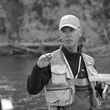
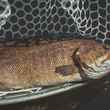








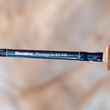
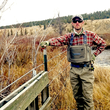



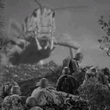
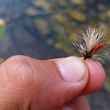

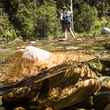
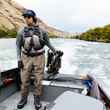
Comments
C B THOMSON replied on Permalink
Great story. I could recognize each and every scenario within this article. Excellent!
Pages